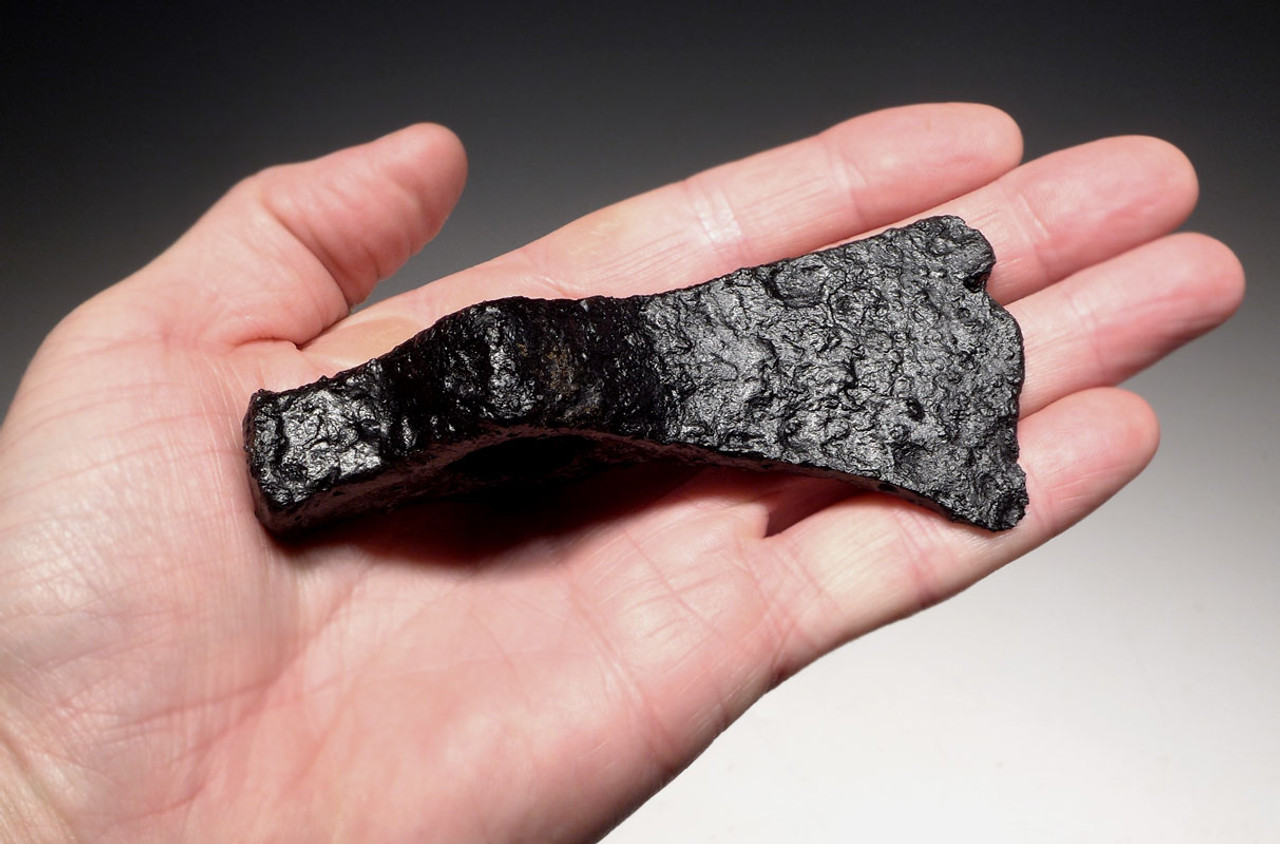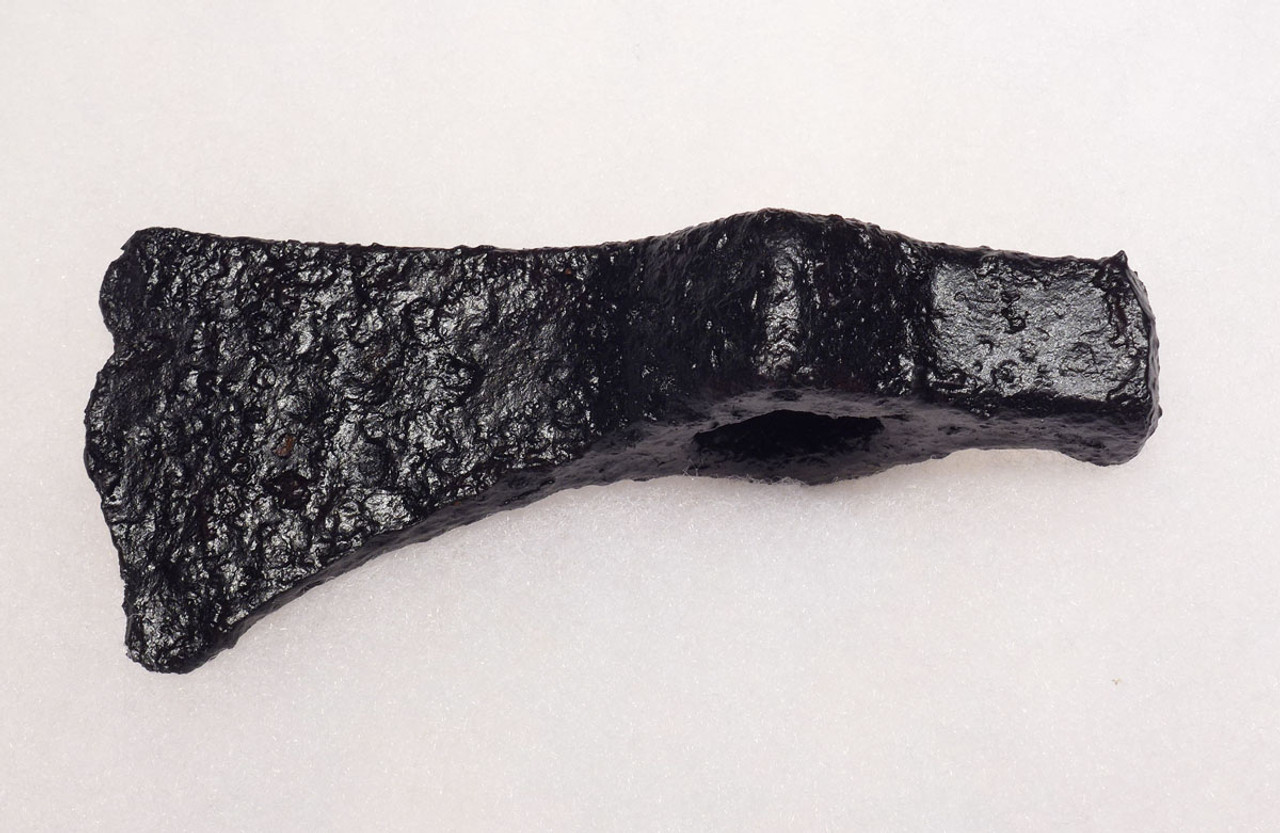Product Description
The axe was a fundamental sidearm of the Roman Byzantine soldiers - both on foot and on horseback. With the many Roman soldiers fighting on horseback at this time, cavalry soldiers needed an axe that was able to defeat armor but also, reduced in size and quick to wield, similar to a tomahawk. This axe was a typical example of that concept and would have been deadly effective with its small but penetrating blade, and weighted hammer end on the butt, when mounted on a longer handle than a foot soldier axe. It is in superb preservation with a diamond-shaped shaft hole body. The back hammer end of the axe would have been ideal to penetrate helmets and inflict a fatal blow. Most fascinating is the obvious evidence of combat use by the damage of multiple impacts on the blade.
When fighting got close and personal, the axe was a devastating weapon and could defeat all forms of armor. The axe required no skill or special training, and could inflict fatal wounds with a single blow, making it one of the most deadly of all ancient weapons. The most feared infantry soldiers of the Byzantine Roman army were the Varangian Guard shock troops, famous for fighting on foot with large iron axes.
This weapon was used by the Byzantine Christian Roman armies defending the Empire's northern border along the Danube River in the present day East Balkans. This region was the northern-most boundary of the Roman Empire for most of its duration and evolution into Byzantium until 1336 AD, when the area fell under Ottoman rule. In the Balkans, Roman camps and fortresses along the Danube were constantly being challenged by opposing tribes and armies. The river served as a natural barrier against attacks from the north. Collected from a region that was once occupied by the Byzantine Roman military as they fought against the challengers of the Christian Roman Empire, these weapons were utilized by Roman soldiers in one of the many violent and frequent battles that took place in defense of Byzantium.
Unlike most metal artifacts sold on the market that are untreated and uncleaned, our specimens our properly cleaned, inspected and conserved in our museum conservation lab prior to being offered for sale to our clients. If ancient bronze or iron is NOT treated and stabilized correctly, IT WILL CONTINUE TO DISINTEGRATE AND CORRODE, AND COULD EVENTUALLY FALL APART INTO PIECES.
THE ROMAN BYZANTINE EMPIRE

Perhaps no other epoch in history is so unique, extensive and yet, as much forgotten as that of the Byzantine Roman Empire. From the founding of its new capitol in Constantinople, 330 AD to its final fall to the Ottoman invaders in 1453, over eleven hundred years of history has virtually been lost in most minds of the Western world. Ironically, it is this exact history that has extensively shaped the Western cultures today, especially those of the Christian faith.
At the fall of the Western Empire in 476 A.D., the Byzantine army was simply the surviving, eastern half of the Late Roman army. Though structurally very similar to its western counterpart, it differed in several important ways notably: It had more and heavier cavalry, more archers and other missile troops and fewer Foederati. These differences may have been contributing factors to the eastern Empire's survival for it was with this East Roman army, that much of the western Empire was reconquered in the campaigns of the generals Belisarius and Narses. During this time under Emperor Justinian I, the revitalized Byzantine Roman Empire reached its greatest territorial extent and the army, its greatest size of over 330,000 men by 540. Later, under the general and Emperor Heraclius, the Sassanid Empire of Persia was finally defeated.
No event in Western history was probably more pivotal than that of the Christian conversion of the Roman emperor Constantine I. Up to that time, Christians were heavily persecuted by many of the previous emperors and the religion was outlawed. That would all change in 324 AD with a miraculous military victory and subsequent conversion to Christianity by Constantine I at the Milvian Bridge. From this point on, Christianity became the official religion of the Empire. A new capitol was established in Constantinople (present day Istanbul, Turkey) and power was fully transferred from Rome to Constantinople in 476 AD. It was not the end of the Roman Empire but a continuation and fascinating transformation of Roman rule that would last for another one thousand years!
 In the Byzantine Period, the Roman Empire and Christianity were completely interwoven. It was the quintessential example of the UNION of church and state. What was once the ancient world's greatest enemy of the faith, overnight became its most devoted advocate. The classic architecture, style of dress, and overall appearance of all that was "Old Rome" took on a new and intricate style that the world has never seen before or since. This was not only attributed to the influence of the capitol's new geographic location, but also to the foremost prominence of Christianity in the Roman world.
In the Byzantine Period, the Roman Empire and Christianity were completely interwoven. It was the quintessential example of the UNION of church and state. What was once the ancient world's greatest enemy of the faith, overnight became its most devoted advocate. The classic architecture, style of dress, and overall appearance of all that was "Old Rome" took on a new and intricate style that the world has never seen before or since. This was not only attributed to the influence of the capitol's new geographic location, but also to the foremost prominence of Christianity in the Roman world.
A well-known remnant of the Byzantine Period is the stunning and unique art of the religious Icons. This abstract spiritual style can be immediately recognized and is evident in not only paintings and mosaics but also the era's architecture and coins. What was once thought of as crude numismatic issues are now appreciated as highly stylized symbols of the Romans' devout faith.
After the establishment of Constantinople as the new capitol and navel of the Roman world, the Empire continued for almost a millennium eventually bridging ancient and medieval history but not without its share of enemies. Numerous challenges of foreign armies took its toll on defenses and finally, on May 29, 1453 AD, the Muslim Ottomans overran the crumbling city walls and the sun set forever on the greatest empire that the ancient world had ever known.
 US DOLLAR
US DOLLAR
 EURO
EURO
 AUSTRALIAN DOLLAR
AUSTRALIAN DOLLAR
 CANADIAN DOLLAR
CANADIAN DOLLAR
 POUND STERLING
POUND STERLING












